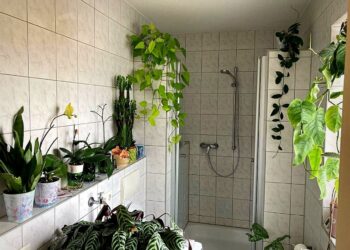Are you looking to reduce the toxins and air pollutants in your home? Choosing the right kinds of plants for your home can help. These plants will not only look lovely but will also purify some of the air you breathe.
House plants bring instant color, vibrancy, and a breath of fresh air into your space. NASA’s clean air study suggested that some plants are more effective than others when it comes to removing the pollutants in your home. A follow-up study done in 2019 found that to make a noticeable difference in the quality of the air, you will need a substantial amount of plants.
Indoor plants have, however, become increasingly popular, a trend that looks like it’s here to stay. Since plants are great in the house anyway, we might as well choose some that will go some of the way in purifying the air we breathe.
Read more: Best Common House Plants
To give your home a touch of color and a breath of fresh air, here is our list of five of the best air purifying plants for the home:
In This Article
Dracaena (Dracaena spp.)

There are about 120 different species of Dracaena plants, many of which are kept as houseplants. They come in all shapes, sizes, and colors making it easy to find one that fits your needs in the office or at home. Pet owners should take note, Dracaena plants are poisonous to cats and dogs when consumed.
Dracaenas are easy to care for, they can survive with or without sunlight but prefer indirect sunlight. They also require very little water, just enough to keep the soil moist. Overwatering this plant will kill it. Take note that some can grow up to 8 feet or more.
They are said to eliminate the toxins formaldehyde, xylene, toluene, benzene, and trichloroethylene from your home.
Spider plant (Chlorophytum comosum)

For those who are new to keeping plants, the resilient Spider Plant is a perfect choice. This plant is one of the few houseplants that are non-toxic to animals, a good choice for pet owners.
Spider plants thrive in indirect sunlight and survive in just about any condition. They send out shoots with white flowers which turn into baby Spider Plants called spiderrettes. You can put the babies in their own pots to grow a whole family of Spider Plants that will pretty much take care of themselves.
There are over 200 species of Spider plants. Most can survive a little forgetfulness from us, but try to water your Spider Plants two to three times a week.
They are said to eliminate the toxins formaldehyde and xylene.
Learn more about spider house plants and growing tips.
Snake Plant/Mother-In-Law’s Tongue (Sansevieria trifasciata)

The Snake Plant, also known as Mother-in-Laws Tongue, is one of the hardest plants to kill and thus an excellent plant for beginners. This plant thrives on neglect since it prefers dryer conditions and tolerates just about any light conditions. This makes the Snake Plant hardy and perfect for just about any room in the house.
The Snake Plant is said to release oxygen at night which contributes to a good night’s rest if kept in the bedroom.
They are said to be one of the best plants to eliminate the toxins formaldehyde, xylene, trichloroethylene and benzene.
Learn more about growing and caring tips of snake plants.
Peace Lily (Spathiphyllum spp.)

Peace Lilies is quite small and thus perfect for compact spaces. It is easy to care for a Peace Lily, just place them in a shady area and keep the soil moist but not wet. If cared for correctly, they will flower throughout most of the summer months.
Peace Lilies can be toxic if eaten by children or pets. They produce a sweet floral scent which is particularly fragrant at night but may trigger pollen allergies in those with hay fever.
They are said to be one of the top three plants for eliminating common household toxins like formaldehyde, benzene, trichloroethylene, xylene, ammonia, and more.
Ficus/Weeping Fig (Ficus benjamina)

The Ficus, also known as the Weeping Fig, is a tree from Southeast Asia. It can grow up to 10 feet tall. They are quite hardy and do well in bright indirect light.
Weeping Figs are quite fussy plants that do not like change, so keep them in the same spot if possible. They might need repotting annually due to their size and growth rate. Water them regularly, but do take note that they need their soil to dry out between waterings
They are said to eliminate the toxins formaldehyde, trichloroethylene and benzene.
Repotting Your Indoor Plants

If your plants outgrow their pots or did not come in attractive enough pots to display in your house, you can easily transplant them. To avoid adding to air pollution, remember to use a clay pot and organic soil.
To give your plant the best chance of surviving the transplant, water it thoroughly before removing it from the old pot. Also, make sure to cut away any roots protruding from the drainage holes as these may trap the plant in the pot.
Pick a pot that is at least one inch in diameter larger than the old pot. You can place a coffee filter or a piece of paper over the drainage holes to prevent soil from falling through. Put about one inch of potting into the bottom of the new pot.
Remove your plant from the original pot by turning it upside down. Hold it at the soil surface and ease (rather than pull) it out of the pot. To promote growth, you can prune any roots straying from the main root ball.
Place the plant into the new pot. Add soil around the edges of the pot until the soil is level with the surface of the plant. Water again and place them in a suitable location.
Read more:














Discussion about this post